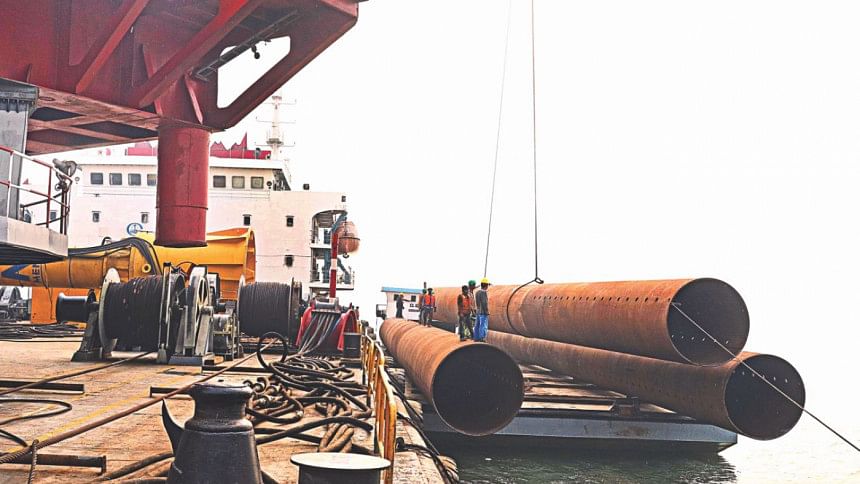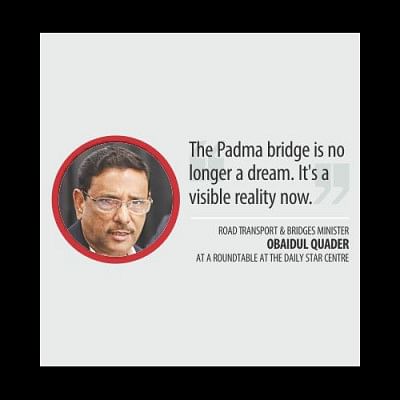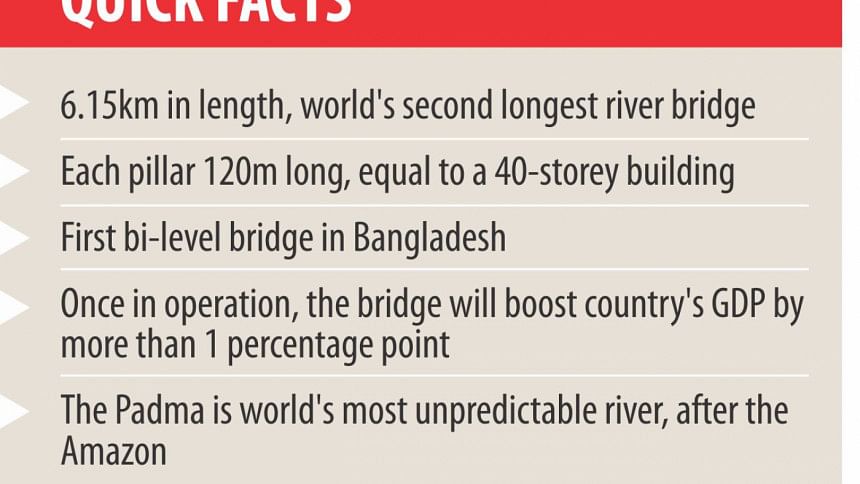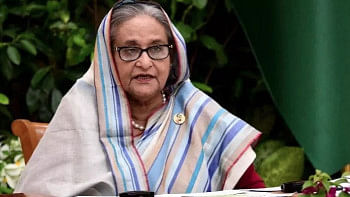Up to an uphill Padma task

The Amazon and the Padma are the two most unpredictable and treacherous rivers in the world. And as the mighty Padma carries huge volumes of sediments making its bed very soft and tricky, building a bridge on it depends on controlling its behaviour.
“Construction of the main Padma bridge is not a challenge. The most difficult part is river training as river erosion takes place frequently,” said Road Transport and Bridges Minister Obaidul Quader at a roundtable in the capital yesterday.
Due to this challenge, engineers would have to install 120-meter long pillars, which is unusual for any river bridge in the world. Moreover, there are very few global experts who can train this unpredictable river, according to the World Bank.
“We are a little concerned about the river training because it is really difficult to predict the nature of its stream,” the minister said.

The river training will now cost Tk 9,400 crore, which was estimated at Tk 4,388 crore initially.
The Daily Star and BSRM, the country's leading steel maker, jointly organised the roundtable titled "Padma Bridge -- New Lifeline of Development" at Azimur Rahman conference hall at The Daily Star Centre.
Prof Jamilur Reza Choudhury, chairman of the panel of experts on Padma bridge, said the bridge was one of the most challenging engineering ventures in the world.
“Perhaps there is no such river training for any other bridges around the world,” he said.
The combined flow of the Ganges and the Brahmaputra passes through the Padma on way to the Bay of Bengal, making it the world's second most enormous water flow. Every second, 140,000 cubic metre of water passes through the river. “We have to ensure a smooth flow of this huge volume of water under the bridge.”
The riverbed is very soft and it can dissolve any time, Jamilur said. “Our estimate is that today's soil may go down below 47 metres next year from the existing riverbed. Besides, saturated soil starts behaving like liquid during earthquakes. So, we have added another 15 metres to that 47 metres.”
He said the world's longest bridge stretching 38km was built in China, but it was on shallow water.
The Jiaozhou Bay bridge in China took only $1.5 billion to build, half the cost of Padma bridge, which is one-sixth in size compared to the Chinese bridge.
“But we have to dig 120 metres which is equivalent to the height of a 40-storey building. Nowhere in the world has a bridge been built going that deep,” Jamilur said.

The pile driving machine, from Germany, has been specially made for the project. “River training is a major challenge. So, latest technology is being used.”
Sagufta Yasmin Emily, a lawmaker from Munshiganj, said there was river erosion during the last rainy season. Sand sacks worth crores of taka were thrown into the river to stop erosion in the first two attempts. But it did not stop. It stopped only in the third attempt.
Building the “dream bridge” with domestic funds was first thought to be the key challenge. Even ministers and party leaders did not think it possible, said Obaidul Quader.
Then there was the issues of land acquisition and rehabilitation of the people. “We could not start the construction if the people from the river banks did not let go of their ancestral land. We are grateful to them,” the minister added.
Talking about the construction of a rail track to connect the capital with the bridge, he said it would be difficult to complete the job in time. “We will rather be able to construct a rail track from Bhanga [in Faridpur] leading to the bridge and open it together with the bridge.”
The army will start upgrading Dhaka-Mawa and Janjira-Bhanga roads into four-lane ones in a week, he added.
Khan Mahmud Amanat, a professor of civil engineering at Buet, said more local experts should be engaged at the field level, but it was not happening.
“As the maintenance of the bridge will have to be done by them [local experts], they should participate in the work closely so they can use this experience in other bridge projects,” he added.
In response, Prof Jamilur said the government tried to ensure the presence of a large number of Bangladeshi engineers who were making decisions on behalf of the government. In the past, foreign experts used to do the job.
“Technology transfer is happening. Management capability is developing,” he said, adding, the international panel of seven experts for the bridge included a Bangladeshi.
In his presentation, Prof AFM Saiful Amin of civil engineering at Buet said construction of the bridge would be a challenge for the country as it would be the largest in terms of length and span -- 6.15km and 150 meters respectively.
Mahfuz Anam, editor and publisher of The Daily Star, thanked the participants of the roundtable.

 For all latest news, follow The Daily Star's Google News channel.
For all latest news, follow The Daily Star's Google News channel. 





Comments